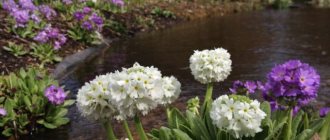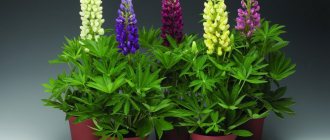It is believed that growing primrose from seeds is quite a troublesome task. This is partly true, but this is due to the fact that after sowing many seeds may not germinate. However, if the activity is carried out correctly, you can achieve good results and grow strong seedlings. And all your investment of time and effort will pay off with the beautiful and graceful flowering of an interesting garden flower.
When to plant primrose seeds for seedlings
The timing of sowing primrose seedlings may vary for different plant varieties. Therefore, pay attention to the information on the packaging; it indicates the optimal time for a particular variety. As a rule, seeds are planted in January, February, March.
But first of all, you need to pay attention to the weather and climatic features of the regions in which cultivation is planned:
- In the South, you can sow in January or early February;
- In the middle zone (including the Moscow region) - in mid-February;
- In Siberia, the Urals, and the Leningrad region, it is better to plant in March.
When deciding when it is best to plant primrose seedlings, many gardeners and flower growers successfully resort to the lunar calendar. It helps you choose not only the most optimal days, but also the unsuitable ones. This plant is a perennial crop, but can be grown as an annual, so you need to take this feature into account. According to the 2022 Lunar Calendar, it is better to sow primrose seedlings as follows:
- Favorable days: in January: 1, 10, 11, 15, 16, 19, 20;
- in February: 7, 8, 12, 13, 14, 15;
- in March: 10, 11, 15, 20, 21, 24, 25.
- Unfavorable days: in January: 2, 18th;
- in February: 1, 16;
- in March: 2, 16, 17, 18, 31.
How to sow correctly?
There are varieties of primroses, for example from the candelabra group, which reproduce naturally ; they just do not remove the dried flowers, leaving seeds to ripen, which self-sow into additional habitat areas, often displacing other plants.
For example, Tibetan primrose and primrose Akaulis have such properties. The seeds of these varieties can simply be scattered where you would like to have such flowers, slightly nourishing and loosening the soil. It’s better to wait until the plant self-seeds and replant the seedlings in the spring.
If we are talking about other varieties, then you will have to try a little. In general, seed primroses develop more slowly and require more attention and time to care for.
What is important to consider?
- The germination of seeds decreases as they lose freshness, so additional measures will be required.
- Watering with hard water is dangerous; this creates a risk of loss of germination.
- In warm weather, seeds also lose their germination potential; coolness is required for effective germination. The temperature should not exceed 17 degrees, the optimal mode is 10-15 degrees.
- Air humidity should be above average.
- Good lighting is important; if necessary, add additional lighting with a phytolamp.
- They are generally sown in November, December or January, and hybrids with a short development period are sown in February-March. From the time of sowing to the start of flowering, it usually takes about six months or a little less. On average, the optimal time for project implementation falls in November-December.
Under normal conditions, seedlings hatch on 10-11 days . After this, you can slightly reduce the humidity and temperature. Around March 15, young seedlings are transplanted into separate pots. And after a few weeks, in May, they are transported to outdoor conditions, to open ground.
Read more about sowing dates and other features of planting perennial primrose here.
Selection and preparation of containers
With the choice of landing container, everything is now very convenient and simple. In any store specializing in goods for the garden and garden, or a regular hypermarket, you can buy a variety of containers for planting. You can also use improvised means, for example, various bowls, cut plastic bottles, etc.
It is very convenient to plant primrose seeds in the following containers:
- plastic box:
- wooden box;
- plastic cassettes;
- peat pots;
- plastic cups;
- peat tablets.
Since flower seedlings need picking, it is very convenient to initially sow the seeds in a common plastic or wooden box, and then plant them . But when growing in peat tablets, there is no need to pick seedlings.
Important! There must be drainage holes at the bottom of the planting container. If you did not find them when purchasing, then you need to make holes yourself. The exception is peat tablets and pots; there is no need to make holes in them!
Before planting seeds, it is recommended to disinfect containers (except peat tablets). Simply rinse the container with a solution of potassium permanganate or a fungicide solution.
Do I need to prune primrose after flowering?
When the primrose fades and dry leaves appear on the bush, its decorative value is significantly reduced. Many gardeners, following the example of peonies and phlox, completely cut off the above-ground part of the flower, thus clearing the garden of non-aesthetic fragments. And this is the main mistake in caring for primroses.
Did you know? In Germany, there is an ancient belief that a girl who finds a wild primrose during the Easter holidays will definitely get married that year. That’s why the Germans call the plant “the flower of marriage.”
Pruning foliage is relevant for primrose only in spring, when the snow has melted . This absolutely cannot be done in the fall. The fact is that after budding, the crop begins to actively grow a leaf rosette. When exposed to cold weather, it sinks to the ground, protecting the root system even when dry from adverse external factors. This is a kind of natural shelter for the primrose.
In specimens with prematurely cut leaves, the bush becomes smaller, flowering weakens and natural decorativeness is lost
Preparing soil for seedlings
The soil for growing primrose must be fertile, light, with good moisture and air permeability . You can buy universal soil for flower seedlings or prepare a soil mixture with your own hands at home. If you are attracted to the latter option, you can mix the following ingredients:
- leaf humus (2 parts);
- sand (1 part);
- turf land (1 part).
of perlite or vermiculite to both purchased soil and home-made soil ; they will improve the properties of the soil.
Before planting, it is recommended to prepare the soil a month (or at least several weeks) by disinfection. You can pickle (sprinkle the soil with a solution of potassium permanganate or a solution of Fitosporin), you can calcinate it in the oven (place the soil on a baking sheet, layer - 1.5 cm, leave for half an hour at 90 degrees), steam (place the soil on a sieve over steam for an hour and a half) or freeze (the soil is kept in the cold for ten days, then transferred to a warm place for the same number of days and again taken out into the cold).
Sanitizing and pruning roses in autumn
Despite the fact that the rose is fertilized, no one has canceled its care. Like any other plant in the autumn, it needs proper soil cleansing and preparation for wintering. The gardener should not forget that autumn is the best time for the proliferation of fungal infections and pathogenic bacteria that can harm any plant. Therefore, all flower care actions should be aimed at preventing the harmful effects of pests of any kind.
The main preventive measures are:
- High-quality and systematic cleaning of the soil from weeds and debris. This means that a responsible owner must ensure that the soil around the flower is completely free of contaminants that can cause bacterial growth and infection of the plant’s root system.
- Sanitary pruning of foliage and shoots. First of all, the lower leaves and twigs, which are most often affected by pathogenic pests, should be cut off. At the beginning of autumn, at a height of 30 cm from the surface of the ground, all shoots and leaves are removed. Thus, fungi and bacteria have no chance to reproduce and damage the rose.
- Sanitation with disinfectants. This procedure is carried out after the bush is cleared of lower shoots and foliage. For this purpose, preparations based on manganese and soda are used. For those who are not sure of the correct preparation and percentage of home-made preparations, you can purchase a ready-made product for processing.
As you can see, the complex of prevention measures is not so large and complex. All actions are as clear as possible and do not have any difficulties in implementation.
We recommend reading these articles:
Red currant sauce for winter meat with garlic Gooseberry sauce for winter meat recipe with step-by-step photos Bell pepper lecho for the winter is finger-licking with tomatoes
Now you can take a closer look at the issue of pruning roses before winter.
Let’s say right away that from the beginning of the autumn period, every gardener should pay special attention to controlling the abundance of flowering and growth of the rose. New bud buds that appear at this moment must be bent at the base to prevent subsequent development
In no case should you cut off the buds, otherwise the growth of new buds may be provoked, which is absolutely not necessary at the moment.
As for the total pruning of garden roses, there is a small specific nuance. Roses that climb are usually simply pinched at the growing points, but those that grow as bushes are pruned almost completely. Thus, total pruning of a bush rose means that its correct implementation should be carried out at the level of the upper five-leaf clover. The cut is made at an angle of 45 degrees with a slope from the upper bud. The distance between them should not exceed 1.5 cm.
Roses are cut several weeks before wintering.
Selection and preparation of primrose seeds
Seed material can be either purchased or collected yourself. If the first option is more convenient for you, then it is recommended to buy primrose seeds in trusted stores and from reputable sellers.
Nowadays you can find many varieties, both hybrid and regular, in specialized points of sale and online stores. Often there are mixtures that include crops of different colors.
Advice! It is recommended to choose the freshest seeds. It is believed that this kind of seed germinates better and is capable of producing the highest quality seedlings.
Pay attention to the packaging with seeds : it should contain all the information about the variety, optimal sowing dates, planting in open ground, and expiration date.
As mentioned above, you can collect primrose seeds yourself . But keep in mind that they are small and should be collected carefully. The seeds ripen in the bolls of the plant; they should be collected in July-August; the seed bolls should be slightly open, but not fully opened. After collection, it is recommended to dry them a little.
Important! Seeds that you collected with your own hands cannot be stored for a long time, otherwise they will quickly lose their viability. And after collection and before planting, you need to store them in cool conditions.
Before planting primrose seedlings, it is recommended to disinfect the seeds . To do this, pour them into a fabric bag or wrap them in gauze, immerse them in a weak solution of potassium permanganate or a weak fungicide for 20 minutes. Then rinse under running water.
Description of the plant
The international name of this flower is primrose (lat. Primula). The genus Primulaceae, to which primrose belongs, is one of several members of the Primrose family. It contains at least 390 species, most of which grow in temperate climates. These are all herbaceous crops, including both annuals and perennials.
Common primrose (Primula vulgaris) is the most common garden primrose. The height of the plant is 10–30 cm. It is characterized by the presence of a rosette of leaves close to the ground, with a short stem in the center.
Botanical description of the genus Primrose:
- distribution area: temperate zones of western and southern Europe;
- in its natural environment it grows under bushes in deciduous forests, in clearings, roadsides, near railway tracks, in open pastures; in areas rich in humus, sometimes on stony loams;
- flowering: February - March;
- flowers: pale yellow with green veins; 2–4 cm in diameter, grow on thin stems;
- fruit: seed capsule;
- pollinators: insects;
- leaf rosette: basal;
- leaves: 5–25 cm long, 2–6 cm wide, wrinkled, gradually tapering towards the stem, with a jagged edge.
Find out more about the auricular primrose variety.
Step-by-step instructions for sowing primrose seeds for seedlings
The scheme for planting primrose seedlings is quite simple. If you know the process technology, you can do everything correctly without any problems. Step-by-step instructions will help you sow seeds according to all the rules:
- Fill the container with soil, water it carefully and thoroughly level the surface.
- Perform shallow sowing (planting frequency - no more than five seeds per square cm; denser plantings are very undesirable). For convenience, you can use tweezers or a wooden toothpick (moisten the end, pick up the seed, and use another toothpick to sweep it into the ground).
By the way! You can plant primrose seeds on clean snow. Just spread the snow over the surface of the soil, scatter the seed on top and wait for the snow to melt. The seeds, along with the snow, will go down to the required depth on their own.
- After sowing, there is no need to sprinkle the seeds on top with soil or sand. The seeds should be lightly immersed in the soil.
- Spray with a spray bottle.
- Cover the container with the crops with a lid, film or glass (to create a mini-greenhouse).
Note! Seeds should be planted according to this scheme, regardless of whether stratification is carried out or whether it is carried out before or after planting.
Video: technology for planting primrose on snow.
Planting primrose in peat tablets differs from the sowing scheme in conventional containers (box, cup, cassettes). You do not need to pre-prepare the soil or disinfect them. All you need to do is prepare the tablets: put them in a tray with warm water for half an hour, they will swell and be completely ready for use. After draining the remaining water, you can plant flowers.
Requirements for landing tanks
There are no special requirements for planting containers for primroses. These can be food containers, packaging left over from food, plastic trays, special mini-greenhouses.
The main thing is that the container has a transparent lid and holes in the bottom to drain excess liquid. Primroses are quite miniature and at first can grow in a common container. In the future, the seedlings will need to be planted into separate cups or small pots.
Mandatory stratification of primrose seeds
This crop has a peculiarity - the seeds need stratification, which is carried out immediately after sowing or before the event . Stratification (that is, hardening) at home imitates natural cold conditions and helps to obtain faster seed germination, uniform shoots and strong seedlings. Indeed, in nature, without human intervention, seeds fall from the seed pod directly onto the ground. They remain on the ground surface throughout the winter, often under snow and in the cold. And after that, wonderful plants grow in the spring.
Almost all varieties of primrose need this procedure (except ordinary and fine-toothed).
Important! Before sowing, it is recommended to study the information on the seed package. Some hybrid varieties do not require stratification; this information will be indicated on the packaging.
Let's consider two main methods of stratification:
Frosty stratification of primrose on snow
A characteristic feature of this method is that the seeds must be kept for some time at subzero temperatures . First of all, sowing should be done according to the standard scheme described above. Then you should immerse the container in a plastic bag.
For frost stratification, it is necessary to place the container with seeds in a place with a temperature of -5... -8°C, but not lower than 10 degrees below zero. A snowdrift is ideal , just place the container in the snow. The container with seeds should be kept in frosty conditions for 10-20 days.
Important! With this method of stratification, there is no need to water the soil before planting, during the procedure and after sowing!
Cold stratification at positive temperatures
This method is objectively simpler; you do not need to take the crops out into the streets and look for snowdrifts. Its main difference from the above is that it is necessary to keep the seeds in conditions with a positive temperature.
Cold stratification can be done using two technologies: prepared before sowing by soaking or sown directly into the soil. Let's take a closer look:
- Soaking the seeds is done as follows:
- Place the seed on a damp cloth, gauze or cotton pads. You can also soak the seeds in a damp foam sponge, which is first cut into two parts; the seed material is located between the parts of the sponge.
- A cloth, cotton pad or sponge with seeds is wrapped in a bag and placed in the refrigerator for 10-14 days. In this case, it is necessary to regularly remove the container and check the seeds, at the same time ventilating them. It is also necessary to moisten with a spray bottle as it dries.
- After the specified period, the seeds are moved to a warm place until germination.
- After germination, you need to sow the seeds according to the standard scheme.
- Immediately after this, cover the crops with film or glass.
- Stratification without pre-soaking carried out using the following technology:
- Sow primrose seeds according to the standard scheme, cover with glass or film.
- Then wrap the container in plastic and place it in a warm place for five days.
- Immediately after the seeds swell, but before the sprouts appear, it is necessary to transfer the container with the seeds to the refrigerator for 10 days.
- After this, the seedlings are transferred to optimal conditions (more on this below).
Caring for chrysanthemums in autumn and winter
To spend less time and effort preparing chrysanthemums for winter, plant flowers of zoned varieties. For example, varieties and hybrids of Korean chrysanthemum are best suited for the Moscow region. But these plants also need a winter coat.
Before the onset of frost, the above-ground part is cut to stumps 10 cm high, the base of the bushes is mounded with humus (10 cm layer), and mulched with dry peat on top of it. In a snowless winter, dry leaves are poured onto a layer of mulch, and then spruce branches are laid on them. If such a shelter does not save your chrysanthemums from freezing, dig them up, place them together with a lump of earth in a container and for the winter put it in a cellar with a temperature of 1 to 5 ° C.
We hope this article will help you maintain perennial plants even in harsh winters. And the attractive flowers will not disappoint you next season.
How to care for primrose seedlings
Regardless of whether the seeds have undergone stratification or not, the seedlings need quality care, which will help to obtain strong seedlings and beautiful flowers in the future.
You need to care for primrose seedlings as follows:
- For germination, it is necessary to provide future seedlings with optimal temperature conditions . After stratification or normal planting (if hardening was not done), you need to move the container with the seeds to a room where the temperature is maintained at 16-18 degrees Celsius . With proper care, shoots appear in about 2-3 weeks.
- You should also take care of proper lighting . It is necessary to place the container in a sunny place, but the light must be diffused ! If you have fine-toothed primrose, Siebold or High primrose, then the container should be placed in the shade, but after the seeds germinate, they are moved to a sunny place with diffused light.
- Monitor humidity . It is necessary to water moderately, do not add a lot of water and do not allow it to dry out. Before emergence, watering should be done by spraying from a spray bottle. After germination, the seedling can be watered from a syringe, watering can or other vessel, but very carefully. Watering is carried out immediately when the surface dries slightly.
- Before emergence, it is necessary to ventilate the container . To do this, remove the lid or film every day for about 15-20 minutes. Wipe any resulting drops from the covering material.
- After germination, the lid or film is permanently removed, but you need to remove the mini-greenhouse gradually! First, the lid, film or glass is removed for half an hour, every day the time increases and after about 10 days the covering material is completely removed.
- Seedlings should be fed as needed, for example, plants grow too slowly and look frail. You can apply fertilizer from the moment the first leaves appear. It is recommended to use complex mineral fertilizers, but the concentration should be 2 times lower than the dosage indicated on the drug. The frequency of feeding is once every 10-14 days . If everything is fine with your seedlings, they are strong, healthy, and growing well, then you can feed them only once or twice during the entire period from sowing to planting in open ground.
Features of storing some varieties in special containers at home
Preservation of the root
After the primrose flowers, if it is not a frost-resistant variety, the plant is usually dug up, the foliage and stems are removed, and the root part is stored in a container with sphagnum moss, in the coldest compartment of the refrigerator.
This temperature is important so that the primrose is not affected by the premature development of leaves. If this does happen, you will have to plant it in a pot and keep it in a cool place. In warmth and low humidity, the flower is in danger of dying .
Overwintering the whole plant
You can remove the primrose from open ground and transplant it into a container, taking a volume twice the above-ground volume of the primrose:
- The root system is cleaned of old soil extremely carefully so as not to damage the thin parts, because they are more fragile.
- Then the primrose is planted in a special composition of soil for indoor flowering plants, mixed with sand, one to one.
- In this case, the basal neck is not buried.
Water only with soft type of water. When the soil settles, add a layer. Place the pot in a place where the temperature is +12-15 °C, with moderate lighting. You can maintain the necessary humidity using a regularly ventilated greenhouse.
With such care, the plant will safely survive the winter and in May it will be possible to send it to the garden. Primrose tolerates transplantation quite easily .
Read about other features of caring for primrose here.
Growing primrose is accompanied by various important nuances of care, one of the most important is preparing the plant for winter; the viability and quality of flowering largely depends on the quality of this stage of care.
It is necessary to carry out the procedure according to all the rules and then the plant will bear beautiful flowers for many years, decorating the garden plot.
If you find an error, please select a piece of text and press Ctrl+Enter.
How and when to plant primrose seedlings
Like seedlings of many crops, primrose seedlings need picking, that is, transplanting into larger containers with a larger feeding area. When is the best time to have the procedure? The optimal timing of picking is determined by the plant - the seedlings should be in the phase of two true leaves . As a rule, when growing this crop, 2 pickings are carried out.
The soil for diving can be used the same as for sowing that you did earlier. However, you need to select other containers. For example, you can choose larger peat or plastic cups or boxes. They must have drainage holes!
Scheme for picking primrose seedlings:
- An hour before the procedure, the plants are thoroughly watered.
- A drainage layer of about 1 centimeter is placed at the bottom of new containers; you can use eggshells or expanded clay. The soil is poured, there should be a gap of about two centimeters between the soil and the edges of the container.
- Small holes are made in the new container. If there is a common container, then there should be a distance of 5 centimeters between the holes. If it is an individual container (pot, glass), then its diameter should be 10 centimeters and one hole should be made. The soil is spilled with warm water.
- The seedlings are carefully removed from the soil using a wooden spatula or plastic spoon. It is necessary to carry out manipulations very carefully so as not to damage the delicate roots.
- Then you need to very carefully compact the soil around the seedling to eliminate air around the roots.
- After transplanting the seedling to a new location, careful watering is carried out.
After picking, it is necessary to place the plants in partial shade for about a week so that they regain their strength and take root. Due to direct sunlight, seedlings may wilt.
If you plan to transplant seedlings into open ground only at the end of summer, then at the beginning of June you should dive a second time. This time you should use individual containers with a diameter of at least 15 centimeters. After the procedure, the plants need to be transferred to a greenhouse.
How to properly prepare for winter
The degree of preparation of primroses for wintering depends on their biological classification. Some species do not require additional care before winter. More delicate varieties must be covered with fallen leaves and agrofibre on top. And hybrid varieties must be replanted annually, together with a ball of earth, into wooden boxes for indoor storage.
Primroses are unique because of the harmonious combination of their simplicity, undemandingness and sophisticated delicate beauty. They have high winter-hardy qualities. But often excessive care and ignorance of novice gardeners lead to freezing of the bushes.
To prevent this from happening, organize all preparatory work according to the algorithm below:
Remove debris and unnecessary vegetation from the flowerbed. Under the snow cover, weeds can be prohibited, thereby provoking putrefactive infections
Act carefully so as not to damage the rosette and its foliage with working equipment. Do not cut it under any circumstances.
Loosen the soil in the area thoroughly and water it generously.
Distribute humus over the root circle of the primrose, leaving the rosette core visible
This manipulation is especially relevant for delicate varieties. When the air temperature drops to -10°C, cover the plants with agrofibre or spruce branches. In the second case, make sure that the thickness of the coniferous shelter reaches 7–10 cm. An alternative insulation option is dry straw or hay. In regions with snowy winters, this manipulation loses its meaning. If the thickness of winter precipitation varies between 25–70 cm, there is no need to worry about the safety of the flower. If there is not enough snow, add it to the flower bed by hand.
Remember that primrose does not need pruning before winter. The only exceptions are non-frost-resistant varieties, which will be stored in containers during cold periods. Their entire above-ground part must be removed.
Primroses are especially popular in floriculture due to their ease of care, early flowering and bright beauty. Competent and timely care for them, as well as compliance with basic agrotechnical rules, is the key to the full development of perennials.
Features of planting in open ground
When to plant primrose seedlings in open ground? Replanting can be done both in spring and summer in the second half of August (if the plant grew outside in a pot all summer). The optimal time for planting in the spring is in May, when you are sure that night frosts will not return, approximately in the second half of the month.
Important! Before transplanting flower seedlings into open ground, it is necessary to harden the planting material. About seven days before planting, the seedlings should be taken outside, increasing the time spent in the fresh air daily. But this can only be done when the air temperature remains stably above 10 degrees Celsius.
Before planting, it is recommended to carefully consider the choice of place for growing primrose . It is better to plant in an area with light, loose, fertile soil, which is protected from strong and cold winds. It is better to choose a place with partial shade, for example, under the canopy of trees or shrubs.
It is necessary to make holes in the garden bed that correspond in size to the earthen ball of the seedlings; they should be slightly larger than the ball. The distance between the holes is 25-30 centimeters for large varieties, and between flowers of small sizes you can leave a gap of 15-20 centimeters.
Primrose seedlings are transplanted into open ground using the transshipment method , that is, the plant is transplanted into the hole without destroying the earthen coma. A few hours before the procedure, you need to water the container with the plants. The planting hole is also thoroughly watered before planting.
After planting, it is necessary to water abundantly. It is necessary to mulch the planting site to protect the plants and provide comfortable conditions for rooting and adaptation in a new place. The mulch layer is 10 centimeters. You can use sawdust and straw.
Growing healthy, strong and high-quality primrose seedlings at home is very simple! To do this, the gardener must act carefully, carefully and according to the instructions, knowing the simple tricks of sowing, picking and caring. By the way, caring for seedlings is very easy; it is enough to satisfy the simple needs of young plants.
What to do in the fall?
Primulas are not as afraid of low temperatures as temperature changes and rotting of roots. Changes, as a rule, occur from the difference in day and night temperatures, as well as from alternating thaws and sudden cold snaps. Hypothermia primrose in winter if the standards are not followed or rotting from excess moisture can lead to loss of germination.
The intense spring sun is also dangerous; it can burn primroses that have not yet adapted after hibernation. The best protection from the cold and a guarantor of climatic stability in the root zone is, of course, snow, but it is not always enough to provide the required degree of protection.
Therefore, in addition to temperature changes and cold weather, they create a shelter from soil with humus and a layer of spruce branches on top. When the snow cover is very thick, there is a threat of overheating.
To prevent rotting during the winter, holes are periodically punched in the snow cover using a pitchfork to create air access to the plant. When the melting begins in the spring, due to the same risk of the plant rotting, you need to partially clean the frozen crust of the crust.
Many varieties have frost-resistant properties and can easily winter without special insulation-shelter , but there are hybrid species that are not at all predisposed to wintering in open ground. During periods of low temperatures, they are removed from the soil and sent for storage in containers in rooms with special conditions.
Do I need to trim the leaves?
Is this flower pruned for winter? If phloxes and peonies are deprived of their aerial parts for the winter, then doing this with primrose is strictly prohibited. After flowering, the primrose rosette often fades and does not create the most aesthetic appearance, but the foliage is not cut off, since for the primrose it is a natural shield from winds and low temperatures during cold weather.
More information about transplanting and caring for primrose in the fall can be found here, and from this article you will learn how to plant the plant correctly.
Primrose herb: medicinal properties
The wild species of primrose is the medicinal primrose, one of the most unpretentious. The ancient Greeks valued it very much for its medicinal properties, they believed that it saved them from paralysis, they even called it “paralysis herb.”
Unfortunately, it is becoming less common in our country and is included in the list of flowers. those in need of protection.
Considering that other types of perennial primrose also have useful qualities, we will describe them in more detail.
- In the spring, you can borrow vitamin C and carotene from primrose, adding it to salads and drying it for the winter.
- The leaves can be applied to wounds for faster healing.
- For colds and bronchitis, a decoction of herbs or roots is taken as a diuretic and expectorant.
- Calming effect for neuroses. insomnia, migraines, headaches.
Pour a tablespoon of boiling water into a glass, leave for half an hour, drink this glass a tablespoon a day.
Hello, dear friends!
Primrose is known to many not only as a beautiful summer flower, but also as a plant with amazing medicinal properties. Primrose root is widely used in folk medicine; it is used to prepare various infusions or decoctions. Decoctions of primrose roots and leaves are used to prevent and treat many diseases.
Today, a huge number of varieties of primrose are known. Among them there are both annual and perennial plants, and sometimes biennials are also found.
The root system of primrose is well developed, the leaves are collected in the form of a small rosette, usually oval in shape. The inflorescences usually have whole or split petals. The colors of plants can be very diverse; a rich color palette allows you to fill the flower garden with the brightest colors, even if there are no other flowering plants besides primrose.
At the end of the flowering period, small boxes with seeds form on the plants.
Choosing a place to plant primrose
In order to successfully grow primroses in open ground at a summer cottage, for planting them it is better to choose those areas where bright sunlight will be present only in the first half of the day. These can be small areas located next to shrubs or fruit trees, so that the shade from the crowns of such neighbors covers the plants from too bright afternoon sun.
Soil for primrose
The soil in the selected area should be well-drained and moist. Experienced gardeners recommend fertilizing the soil at the site of future planting of primroses with manure so that the soil is rich in nutrients and retains moisture well, but is not too moist.
Caring for primrose in open ground
The main measures for caring for primroses will be regular watering and timely loosening of the soil, since the root system of the plant requires a constant flow of oxygen for the favorable development of the plant as a whole. It is also necessary to periodically remove weeds from the territory occupied by the primrose so that all the nutrients from the soil reach the primroses.
Feeding
During the entire growing season, primroses must be fed. The frequency of feeding will be approximately once every twenty or twenty-five days. Additional nutrition of plants is carried out using phosphorus-potassium fertilizers. Also during this period, it is recommended to periodically water the plants with liquid organic fertilizers.
Popular types and varieties
The genus Primroses is one of the most numerous; More than 400 of its representatives have been found in nature in different parts of the world, and new species of primrose continue to be found to this day. In this regard, the classification is regularly updated. A little less than a third is cultivated. To facilitate “accounting,” the genus of primroses is divided into subgenera.
| Subgenus name | Description | Popular varieties of primroses |
| Primula orchid or Viala | Biennial. The leaves are elongated, up to 30 cm, lanceolate, with a finely toothed edge. The flower arrow is tall, up to 15 cm; inflorescences are conical, consist of many small bell-shaped flowers with a pleasant aroma | In gardens it is found in two variations: red-lilac and red-white. |
| Ordinary (stemless), or garden | Perennial. The leaves are oblong-lanceolate, rounded, toothed, strongly wrinkled. The flowers are funnel-shaped, up to 4 cm in diameter; collected in dense sessile inflorescences | Akaulis is a popular series with brightly colored petals and a contrasting “eye” in the center. Matryoshka is a series sold in the form of a mixture of seeds; It is distinguished by its compact, up to 20 cm, bush size. Virginia – white; with a yellowish core |
| Siebold | Perennial. The leaves are ovate-oblong, covered with grayish hairs. The flowers are small, collected in dense inflorescences of 12-15 pieces. | Late Snow – snow-white petals with a carved edge. Kumor – soft lavender flowers. Pink primrose is one of the hybrids, the name of which has not been preserved, with a light center and a darker edging of the petals |
| Chinese | Perennial. The leaves are heart-shaped, divided into 7 lobes. Flowers are about 2-3 cm in diameter | Stellata - a series with white, blue and red petals and a yellow core |
| Serrated | The leaves are dark green, lanceolate, rounded, embossed, with a corrugated edge; covered with silver hair. Collected into a tight socket. The peduncle is tall, up to 30 cm. The inflorescences are umbellate, large | Alba - snow-white bell-shaped flowers with a yellow core, collected in a large “ball”. Violet – purple, with a lighter core. Rubra – dark ruby, with a yellowish center |
| Cortusoid | Perennial. The leaves are ovate, covered with soft wavy hairs. Corolla up to 2 cm in diameter, petals heart-shaped | There are white varieties with a red core and reddish varieties with a white center. |
| Ushkovaya | The leaves are smooth, spatulate, obovate; covered with a grayish coating. Peduncle up to 20 cm in height, flowers are medium-sized, collected in inflorescences of 6-7 pieces; have a pleasant aroma | Suzanne is double, with wavy tonal pinkish petals and a yellow center. Blue Wave - bluish-violet petals with radial strokes. Zambia – dark red double flowers |
| High | The leaves are wrinkled, lanceolate, pubescent on both sides. The flowers are small, collected in inflorescences of 25-30 pieces. | Colossea - crimson petals with a bright yellow center. Duplex - bright crimson petals with a yellow center |
| Japanese primrose and bullea | The leaves are oblong-oval, up to 25 cm in length, with a serrated edge. Peduncle up to 50 cm; large dense inflorescences | Apple Blossom - pinkish petals with a crimson eye. Valley Red – cherry monochromatic flowers |
Sometimes natural species are also found in gardens, for example, spring primrose, also known as “ram” or “keys”. Its golden inflorescences resemble a bunch of keys, which, according to legend, open the “door to summer.”
The diversity of primroses is constantly increasing thanks to the work of breeders. The main “material” for work at the moment is the auricular primrose, on the basis of which two-, three-color and fancy hybrids, both simple and double, have been bred. Another variety of primrose that is actively used for breeding purposes is obconika (reverse conical). It is cultivated not only as a garden crop, but also as a potted crop.
Diseases and pests
Often the plant is under threat of infection with rot, which covers the root collar and surface of the stems. In addition, primrose leaves suffer from jaundice, powdery mildew and other dangerous infections. Signs of most diseases are changes in the color and shape of the leaves. Diseased shoots should be removed immediately to prevent the spread of the virus.
The vegetative parts of primrose attract the following insects: spider mites, weevils, aphids. The leaves are eaten by slugs and beetles. To combat the disease, chemical treatment of bushes with a solution of Topsin or Fundazol is used. It is allowed to spray the leaves with one percent Bordeaux mixture. It is better to hold such events in the spring. For the purpose of prevention, at the end of the season, the flower is treated with a weak solution of Nitrafen. To get rid of beetles and slugs, you will have to work hard to collect them yourself by placing traps in the area.
Perennial garden primrose
The types are listed above. mostly winter well in the open ground of central Russia. All of them are perennial or biennial plants. The rules for caring for each type are similar.
In the first year of life, before wintering in the open air, they will not be prevented from feeding them with humus, peat or dry leaves. Then the primrose will feel safe, and in the spring... In the spring we will be greeted by a riot of colors - some primroses form inflorescences already against the backdrop of last year's wintering foliage. If late-blooming primroses are planted next to them, such. like auricular ones, flowering will last until mid-summer.











